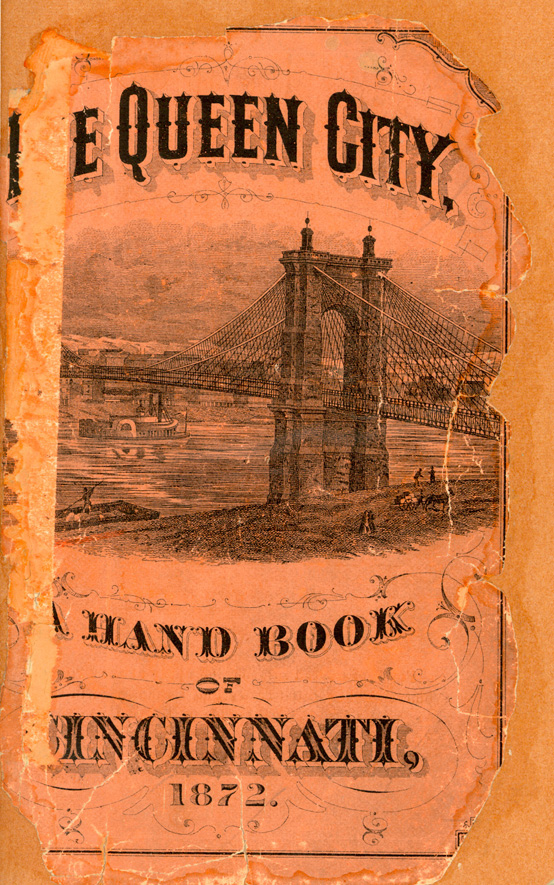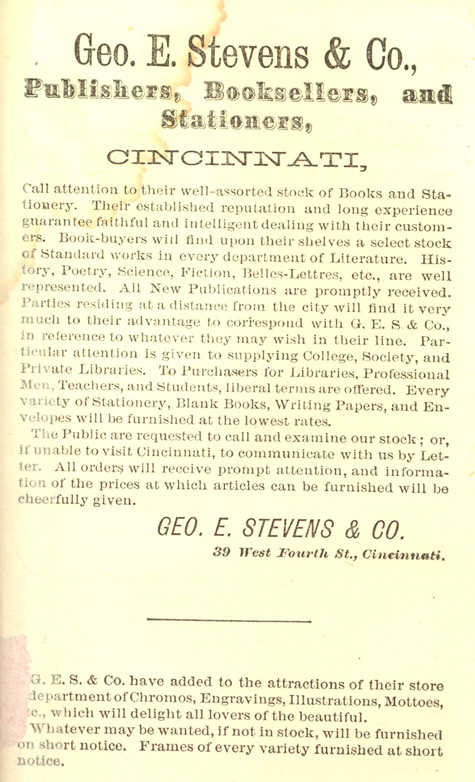By: Tyler Morrison, ARB Student Assistant
 While the rare book holdings of the Archives & Rare Books Library contain everything ranging from cuneiform and papyrus to Renaissance manuscripts and modern first editions, like every other institution, we also focus on particular genres. Among these specialties are the history of the book; 18th century British literature; the Arts & Crafts Movement; Charles Dickens; Irish literature; and early travel and exploration. And because we are in Cincinnati and UC is such an integral part of the city, of course we have many rare and important Cincinnati imprints ranging from the early days of the city’s founding to books published only recently. Included in the many books on Cincinnati is The Queen City: A Hand-Book of Cincinnati. Because the book dates back more than one hundred years, it has been restored so that it remains in a useable condition and its value as a part of local history is preserved.
While the rare book holdings of the Archives & Rare Books Library contain everything ranging from cuneiform and papyrus to Renaissance manuscripts and modern first editions, like every other institution, we also focus on particular genres. Among these specialties are the history of the book; 18th century British literature; the Arts & Crafts Movement; Charles Dickens; Irish literature; and early travel and exploration. And because we are in Cincinnati and UC is such an integral part of the city, of course we have many rare and important Cincinnati imprints ranging from the early days of the city’s founding to books published only recently. Included in the many books on Cincinnati is The Queen City: A Hand-Book of Cincinnati. Because the book dates back more than one hundred years, it has been restored so that it remains in a useable condition and its value as a part of local history is preserved.
In the 19th century, Cincinnati was a hub of publishing activity. In 1868, it was the first city west of New York to have a company that used a steam powered printing press, indicating a great future in the publishing industry. The city was considered to be a regional book-trade center. George S. Blanchard, a well-known publisher of the time, partnered with George E. Stevens in Cincinnati under his continuing firm name of George S. Blanchard and Company. Their publications consisted primarily of reprints of un-copyrighted standard works, including Gaussen on the Bible and The Works of Lorenzo Dow. However, Stevens himself wrote and compiled one of the copyrighted western books that was published by George S. Blanchard and Company: The Queen City in 1869. When Blanchard withdrew from the company in 1869 to move to Boston, Stevens kept the business alive at the original store under the name Geo. E. Stevens & Co. He continued to operate the firm primarily as an outlet for eastern publications and expanded the store, taking an entire building on West Fourth Street, right in the center of action in the Queen City. Stevens made himself a reputation as an honest and fair bookseller who kept up to date with his customers’ interests. According to the handbook, “Cincinnati ranks fourth among American cities in the manufacture of books. . . . Immense capital combined with skill of the highest order furnish unsurpassed facilities for the production and distribution of books of the best class in every department” (Stevens, 1). Millions of books were made and sold in Cincinnati each year.

Promoting the city is apparent, both in the embellished typography of the city’s name and the claim that Cincinnati is the finest in-land city of America.
An important genre in American publishing at the time was that of city handbooks, providing an invaluable resource to new arrivals in the United States as well as strangers and residents trying to learn more about their city. These helpful books contained illustrations, advertisements, fold-out maps, street directories, and a guiding text to help people negotiate their way around large metropolises. One could theorize that these guidebooks were the start to the modern-day travel literature now used to guide people through unfamiliar domestic cities and foreign countries. Among these many books was The Queen City: A Hand-Book to Cincinnati, which endeavored to promote the city and to expand people’s knowledge about its attractions and advantages, both as a place of residence for over 250,000 residents and as a center of trade. The handbook made the stranger to the city aware that navigating its streets was simple, as it was a compact city offering a variety of means of mass transit. The leading hotels were listed, of which there were many notable places such as the Gibson House. Fourth Street is where commerce and manufacturing could be seen in action, as it was a center of industrial activity in the city as well as the promenade. The view of the Suspension Bridge from the levee was listed as a prominent architectural sight to see, with towers that were two hundred feet high. Pictured on the cover of the handbook, the bridge was newly built when the book was published.
The layout of the city was provided to the wandering individual. The great staples of the market—iron, cotton, sugar, tobacco—were handled along Front, Water, and Second Streets and Pearl Street was the center of operations for a high amount of capital from the distribution of dry goods, notions, clothing, and shoes. The styles and sizes of residential dwellings were discussed, such as how the West End was rapidly expanding in extent, beauty, and population in 1872. Although some 21st century drivers complain about the hills of Cincinnati, the handbook discusses their magnitude that created magnificent views of the land and the river as a prime feature of the city. All the hills contained potential building sights that provided such vistas to the homeowner. In 1872, one of the chief attractions of the Queen City was the suburbs: “The vicinity of no city on the continent can furnish more enjoyable drives, more splendid landscape views, or more beautiful residences” (30). Clifton, Avondale, and College Hill may now be thought of as different segments making up the city itself, but in the 19th century these were the suburbs that were a short drive outside of Cincinnati. As this handbook demonstrates, Cincinnati has developed and expanded immensely since 1872.
For more information about Cincinnati’s history or the Cincinnati books held in the Archives and Rare Books Library, feel free to search our library catalogue at http://uclid.uc.edu/search/X or contact us at archives@ucmail.uc.edu, 513.556.1959, or visit us on the web at http://www.libraries.uc.edu/libraries/arb/index.html. We are located on the 8th floor of Carl Blegen Library.
Sources:
Stevens, George R. The Queen City: A Hand-Book of Cincinnati. Cincinnati: Geo. E. Stevens & Co, 1872. Call number: SpecCol RB F499.C5 Q5.
Sutton, Walter. The Western Book Trade: Cincinnati as a 19th Century Publishing & Book-trade
Center. Columbus: Ohio State University Press, 1961. Call number: SpecCol Ref Z473 .S93.

